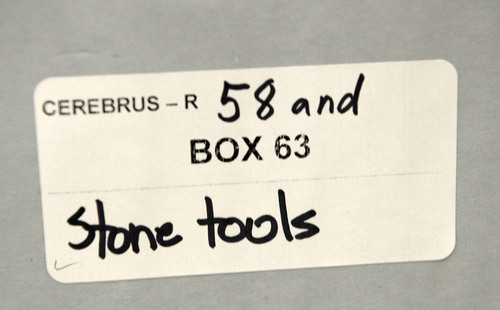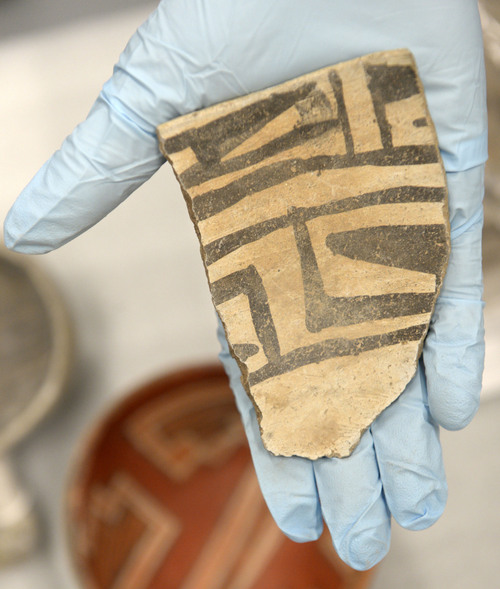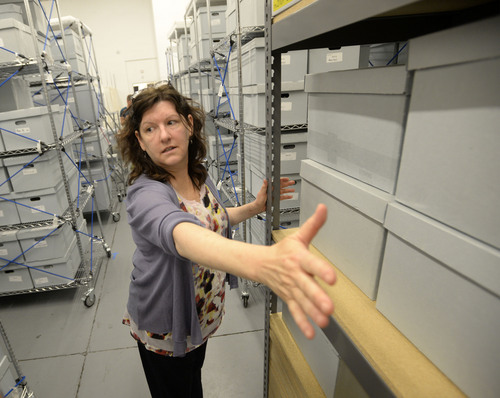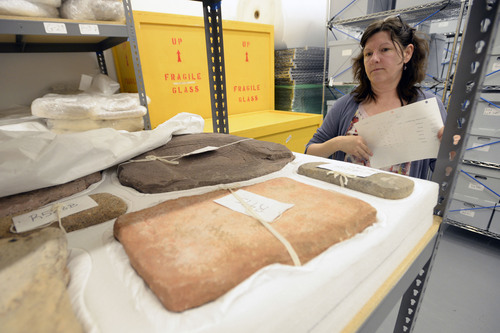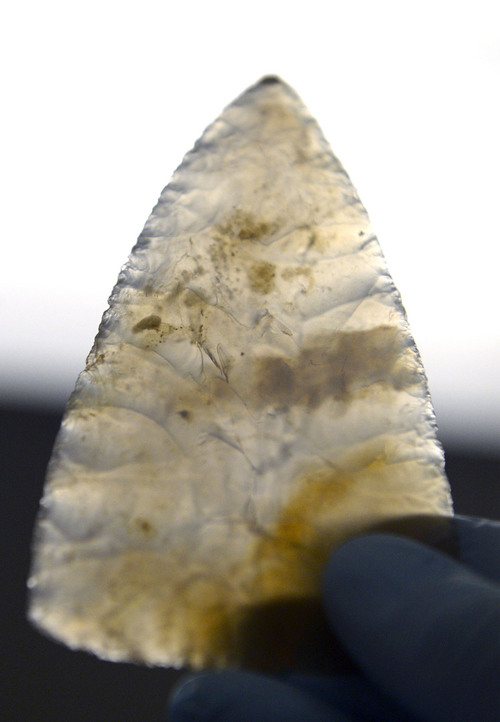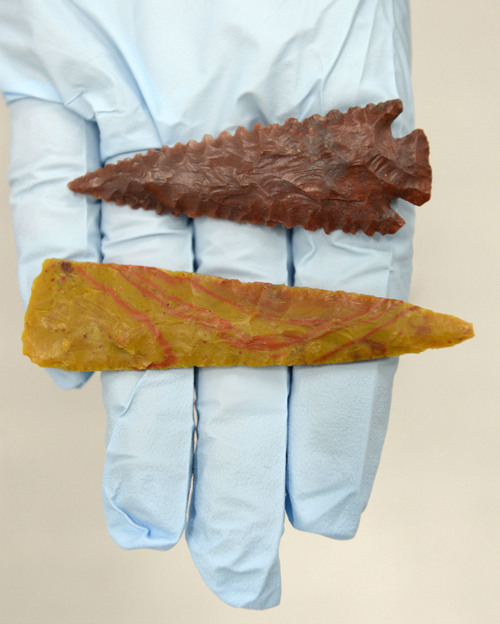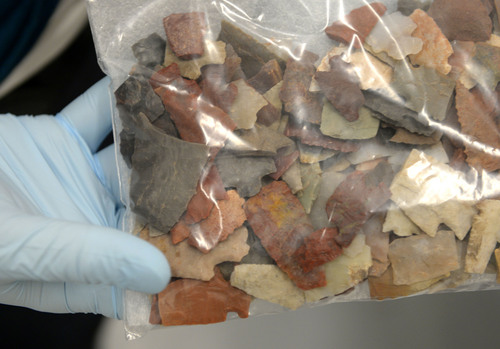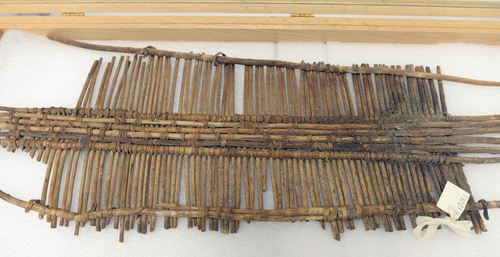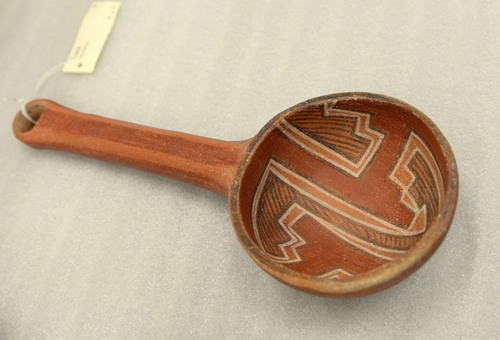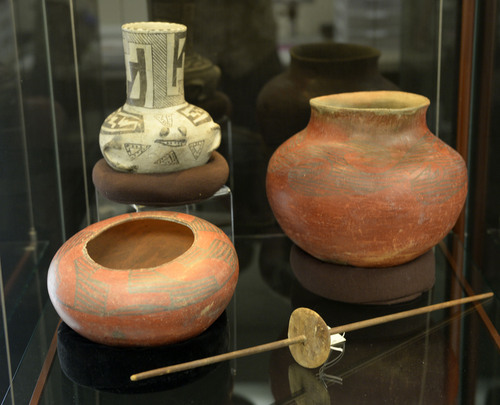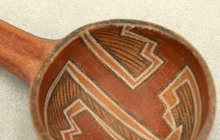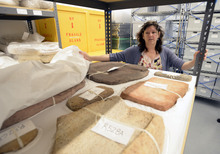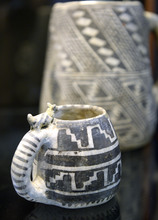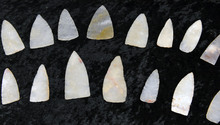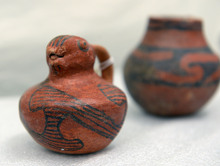This is an archived article that was published on sltrib.com in 2014, and information in the article may be outdated. It is provided only for personal research purposes and may not be reprinted.
One of the nation's most extensive and valuable troves of American Indian artifacts fills a nondescript warehouse in the Salt Lake Valley, where federal curators are preserving pottery, cradle boards, projectile points, hand tools, pendants, grinding stones and thousands of other items illegally removed from ancestral Puebloan sites in the Four Corners region.
When the Bureau of Land Management raided the homes of antiquities collectors in Blanding and other towns in 2009, it was bent on ending the looting of ancient graves and ruins on the Colorado Plateau.
But in the process the federal agency took on a gargantuan task — caring for and documenting more than 6,000 objects that had been stripped of their archaeological context.
Now, BLM officials are finding permanent homes for these artifacts, hoping to send many back to any of 28 modern Southwest tribes that can show a cultural affiliation to specific items. The rest could wind up in museums, although their scientific value has been hopelessly compromised along with the archaeological sites from where they were stolen.
"The unprecedented task we have is trying to make some right out of it, how to restore what we can to Native Americans, how can we make some educational value so these kinds of things don't happen again, how can we stress the damage that has been done," said Shelley Smith, BLM's deputy Utah state director for natural resources.
—
'These are holy objects' • In the five years since the raids, just one of the artifacts has been repatriated — a sacred "Dilzini Gaan" headdress made from painted wood and cloth.
Its distinctive features indicated a strong cultural affiliation with the White Mountain Apache, who reside on Arizona's Fort Apache Reservation, according to a posting last year on the Federal Register.
"There are these PhDs out there to tell us in scientific terms what these are, but you have to be Apache to know what you are talking about. The elders have identified these, including the material and the wood, and where it came from," said Ramon Riley, White Mountain's cultural resources director.
Last year, BLM officials returned the headdress to Fort Apache and tribal authorities laid it to rest it in a special ceremony.
"Anything we repatriate we don't put on display. We retire them," Riley said. "Everything in the circle of life is alive for us. These are holy objects. We pray and put them away."
The headdress was also connected to White Mountain by a famous image created in the early 1900s at Fort Apache by the ethnographic photographer Edward Curtis. The photograph shows Apache medicine men wearing a headdress much like the one BLM agents seized from the home of a Blanding defendant.
Officials do not know where that person obtained it, although Riley believes it had been looted.
—
'Where it started' • In Blanding and surrounding counties, residents once openly gathered artifacts and such collecting was considered a legitimate family activity. The laws changed in the 1970s, criminalizing the removal of artifacts from tribal and federal land.
But looting persisted, to the dismay of archaeologists and American Indians. Graves were a favorite target because they tend to yield intact objects buried with the dead.
The point of the "Operation Cerberus" investigation was not to jail looters, BLM officials said, but to rein in the illegal antiquities trade.
"You can't put [an artifact] back, but it is forever out of the black market. This effort was to start unraveling it where it started," said Smith, an archaeologist who served as BLM's Canyon Country district manager at the time of the 2009 raids.
Around 2006, federal agents recruited a Utah collector to go undercover and secretly record illegal transactions and conversations with several collectors from Blanding, Monticello and Santa Fe, N.M., as well as Durango, Colo., antiquities dealer Vern Crites.
Some of Blanding's most prominent citizens were charged in a series of prosecutions that gnaw at this community to this day. Two defendants, including physician James Redd, and the undercover operative, Ted Gardiner, took their own lives.
No one served jail time, but defendants were required to hand over their entire collections.
The volume of surrendered material dwarfed the 256 items at issue in the criminal charges, such as a hafted axe and a gourd containing a shell necklace that Jeanne Redd, James Redd's wife, showed Gardiner. She told him they came from Floating House Ruin in Chinle Wash, which is in on tribal lands.
The biggest haul came from Crites' Durango home, where officers discovered a secret room filled with artifacts. Another 800 objects were recovered from the home of James and Jeanne Redd.
The Redd family sued the BLM and the officers who searched the home, alleging their "excessive force" and overbearing questions drove Redd to connect a hose from the tailpipe into his Jeep the day after a four-hour interrogation in his garage.
Portions of these suits have been dismissed, and U.S. District Judge Robert Shelby is deciding whether to dismiss the remaining claims against two agents.
While Redd family members continue to profess James Redd's innocence, Jeanne Redd and her daughter pleaded guilty to possessing several looted artifacts. Jeanne Redd's journals helped BLM curators determine where some artifacts were excavated.
—
Sherds, stones, tools, toys • The BLM has since catalogued hundreds of baskets, pottery vessels of all kinds, hand tools, cooking utensils, toys, ritual items, pendants, cradle boards, grinding stones and numerous other things used by ancient American Indians, according to BLM curator Nancy Mahaney, who supervises the warehouse repository.
Most are associated with the Anasazi, a culture that flourished on the Colorado Plateau from 750 AD to 1200 AD and the ancestors of the Hopi, Zuni and other Puebloan communities.
The actual number of individual items may far exceed 6,000 since many were catalogued in lots. For example, officers recovered countless sherds, many used as landscaping decorations at the Redd home. Broken pottery pieces are now contained in dozens of boxes weighing 20 to 25 pounds each. The facility also holds hundreds of metates, or mealing stones, and manos ancient American Indians used to grind corn.
Some defendants "were using some of the grinding stones to line their driveway. How they got them out of the site and to their house is a good question," Mahaney said.
Under the Native American Graves Protection and Repatriation Act, tribes may claim artifacts looted from federal lands, as well as human remains held for decades in some of the nation's most prestigious museums.
The 1990 law, better known as NAGPRA, requires federal agencies to inventory any "Native American funerary object, sacred object, or object of cultural patrimony" in their possession and consult with appropriate tribes to establish the objects' cultural affiliation.
—
What is sacred? • Deciding what qualifies as "an object of cultural patrimony" is best left to the tribes, experts say.
"These are living cultures that descended from the tribes that inhabited that region. I'm not going to tell a Native American what may or may not be sacred to them. I can't stress the importance of consultation enough," said Kara Hurst, registrar for the Smithsonian's National Museum of the American Indian in Washington.
As Operation Cerberus was underway, federal agents retained Hurst, then working for the Natural History Museum of Utah, to care for the items Gardiner purchased. She also trained BLM field staff to properly record, package and transport artifacts seized from the suspects' homes, and later worked for the agency.
With the help of the defendants, Hurst, Mahaney and other BLM officials identified at least 100 artifacts that were stolen from the Navajo reservation. The agency intends to hand those over to the Navajo Nation without going through NAGPRA's arduous process, Mahaney said.
Establishing affiliations for the remaining objects will not be so easy. The BLM has twice assembled tribal representatives, covering their travel and lodging costs, at the repository to view the items.
The nine Apache tribes work together on repatriation claims to avoid fighting among themselves over specific objects, according to Riley. His White Mountain tribe hopes to repatriate any stolen artifact as soon as possible, regardless of how their ancestors used it.
"To Indian people everything is alive and sacred. They want us to prove that it is sacred or not sacred. That is a stupid question to ask. You have to live the life of an Apache and be a part of our land," Riley said. "We were put through genocide and we are still here."
—
Caring for history • Because of the sheer volume of artifacts and the number of tribes with potential claims, repatriation could take years. In the meantime, the objects must be secured in an optimal climate.
Many of the perishable artifacts made from organic fibers, such as sandals, cordage, baskets and feathered blankets, are in temporary storage at the Natural History Museum of Utah, whose new facilities near Red Butte Canyon can more precisely control temperature and humidity.
"With perishables you don't want humidity or temperatures to get too high because you get growth of different kinds of things," Mahaney said.
To kill any stowaway bugs, many of the artifacts and their display cases were put in freezers before they were brought into the BLM repository. Traps placed throughout the building reveal what kind of insects are getting inside.
Ultimately, objects that aren't repatriated could end up in museums, most likely those close by, such as Blanding's Edge of the Cedars Museum State Park. Museums receiving artifacts recovered from federal lands must meet rigorous requirements for keeping them safe, accessible to researchers and available for public display. They can charge the government a one-time $550 curation fee for every cubic foot they take.
The Blanding facility already holds 500,000 artifacts, including some from the collection of convicted looter Earl Shumway.
"I can't say when or if. It's a very long process and people get impatient but the process is indicated by law," Edge of the Cedars director Teri Paul said. "If we took all of it today, it would fill up our facility and what do we do about future curation? The longer it takes, the less space we will have for them."
What is NAGPRA?
Passed in 1990, the Native American Graves Protection and Repatriation Act requires federal agencies to document American Indian artifacts and human remains in their possession. The law establishes a process for returning certain items to tribes that claim cultural affiliation with them.
The Bureau of Land Management is now consulting with 28 Southwestern tribes that have potential claims on the more than 6,000 artifacts the agency seized as a result of a lengthy undercover investigation into an illegal trading network centered in Blanding.



